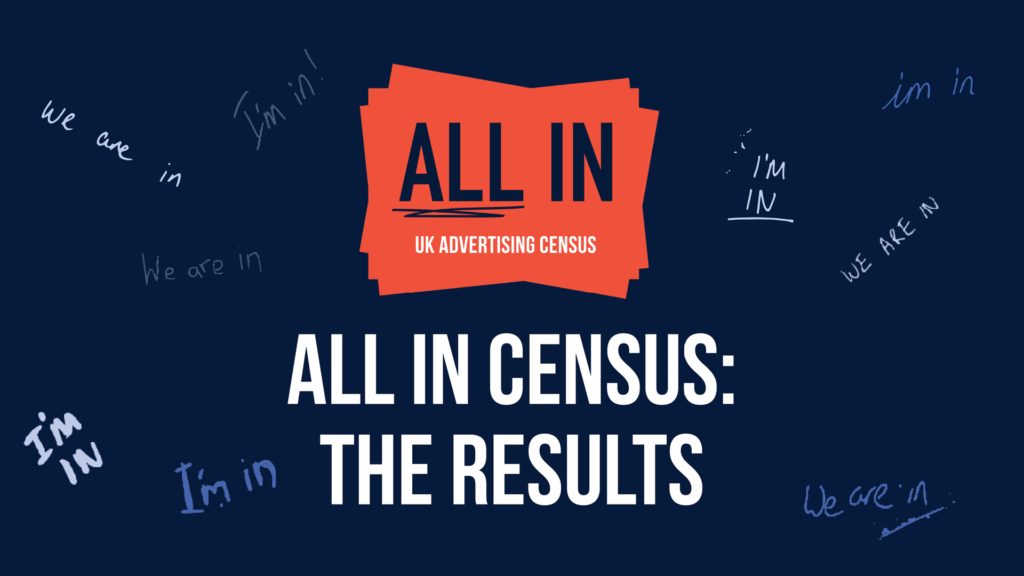2025’s All In Census: Is the Ad Industry Trustworthy? 60% of Members Don’t Think So
by on 9th May 2025 in News

We look at some of the key findings from this year’s All In Census (created by the Advertising Association, the IPA, and ISBA), revealed on Thursday at News UK’s London headquarters by Dan Wilks, director of Credos.
On Thursday, the results of this year’s All In Census (carried out in March) were revealed. The results expose the current state of diversity in the ad industry, also bringing up some questions surrounding the nature of the industry itself and how it’s viewed by those working in it.
An untrustworthy industry?
Out of the survey’s 14,000 respondents, only 40% feel that advertising is a trustworthy industry to work in. In line with this, only 44% of respondents believe that advertising has a positive impact on society.
Yet, 78% of respondents report enjoying working in the industry. This certainly raises questions around why those working in advertising enjoy it. Is it easy to look beyond these – quite serious – issues? Or are there benefits of working in the industry which outweigh these cons? Is it simply deemed better than working in many other industries?
Women’s climb to the C-suite
On a more positive note, gender representation in the ad industry is getting better. However, we are still far from reaching equal representation for women when it comes to securing C-suite positions. This year, six in ten (60%) of the survey’s respondents were women, while 46% of C-suite roles were held by women. Although there is considerable room for improvement, the figure is higher than previous years (43% in 2023, and 39% in 2021).
Gender experience
Sexual discrimination is still a problem for the industry, with 10% of female respondents saying they had experienced it within the past 12 months, versus 3% of male respondents. This figure rises to a staggering 42% for trans respondents. Six in ten (60%) trans industry members also report being made to feel uncomfortable in the workplace, versus a 15% average among all respondents. Around a quarter (23%) of trans respondents say they are likely to leave the industry due to a lack of inclusion/discrimination, versus a 9% average among all respondents. It’s worth bearing in mind that this data was collected before the UK Supreme Court ruling last month regarding the legal definition of a woman, which will likely embolden many to express transphobic opinions.
Examining ethnicity
Ethnicity representation in C-suite positions is another area in which the industry lacks diversity. Representation across the overall ad industry is fairly strong: 4% of respondents are Black (versus 3% of the UK working population), 8% Asian (mirroring the UK working population), and 5% mixed race (versus 2% of the UK working population). All ethnic minorities make up 18% of ad industry respondents, versus 14% of the UK working population. However, only 11% of ethnic minorities hold a C-suite position.
Racial discrimination remains a problem, with 16% of Black respondents reporting having experienced it, and 12% of Asian respondents. These figures were lower than those reported in 2021 (22% for Black respondents, and 15% for Asian respondents). This drives many to consider leaving the industry. Around a quarter (24%) of Black respondents consider leaving due to lack of inclusion/discrimination; the same can be said for 19% of Asian respondents, 14% of mixed race respondents, and 19% from any ethnic minority group. The positive is that these figures are moving in the right direction: in 2021, 32% of Black respondents, 27% of Asian respondents, 19% of mixed race respondents, and 26% of any ethnic minority said they were likely to leave the industry due to lack of inclusion/discrimination.
Religion also remains a cause for discrimination, with 12% of Muslim respondents citing this (down from 16% in 2021). A breakdown of gender among these categories is yet to be revealed – this would be key to seeing how people’s work lives are affected by the intersections of gender, ethnicity, and religion.
Disability
The number of disabled respondents (using the definition from the UK Equality Act) is close to the number of disabled people in the UK working population (12%, versus 14%); 9% hold a C-suite role in the ad industry. Eight percent report experiencing discrimination due to their disability. However, some questions are left unanswered here, as the survey did not inquire whether respondents’ disabilities were visible or not. Those non-visibly disabled would have a distinct advantage over those visibly-disabled. Additionally, many people who meet the Equality Act’s definition of disabled do not identify as being disabled.
The working class is significantly underrepresented
The working class (using the definition outlined by the UK Government’s Social Mobility Commission) is still significantly underrepresented in the country’s ad industry. They make up only 19% of the ad industry, while making up 40% of the UK population. There is clearly still a long way to go to make the ad industry more class inclusive. More needs to be done to recruit staff from all socio economic backgrounds.
Embracing diversity
As an industry that celebrates creativity, imagination, and originality, we need to embrace human diversity. We all have very different lived experiences of our own to bring to the table. A diverse workforce gives life to more authentic advertising. Having diversity of class, gender, race, sexuality, religion, and all lived experience, allows us to tell more varied stories with heart. This creativity in thought is born in workplaces which create a feeling of safety for staff, championing acceptance and open-mindedness.








Follow ExchangeWire